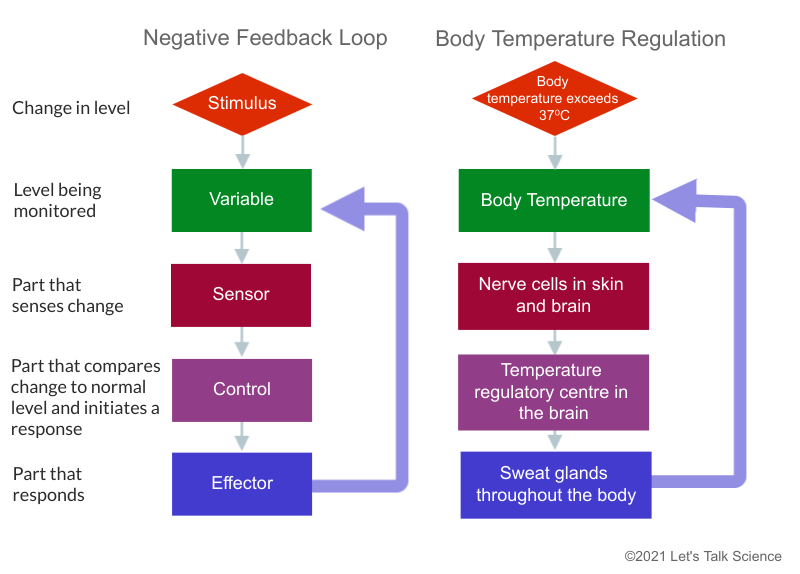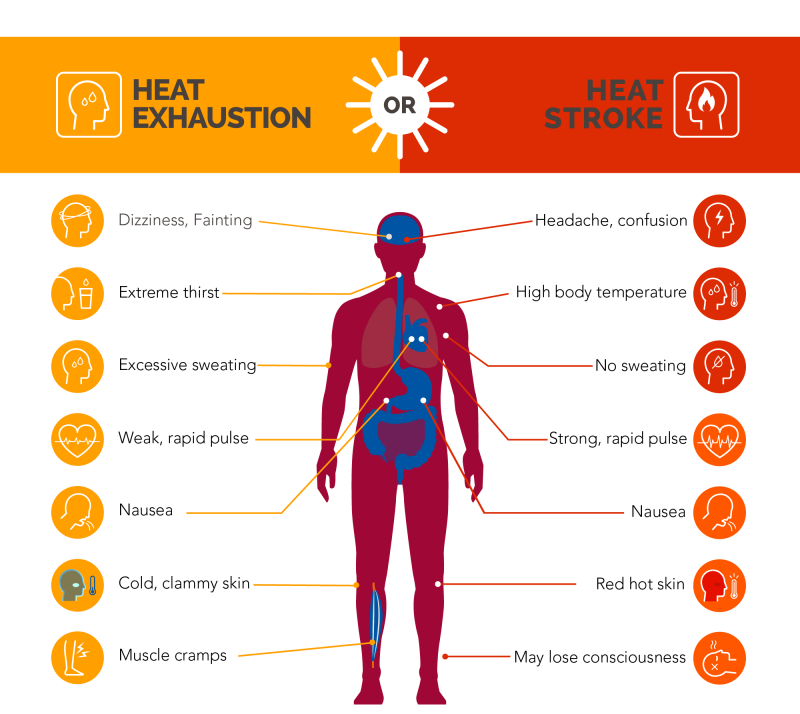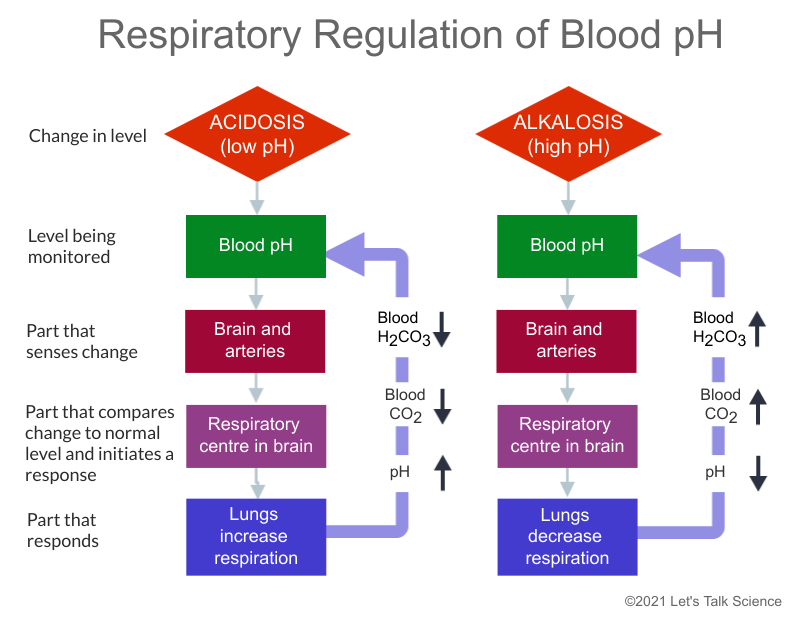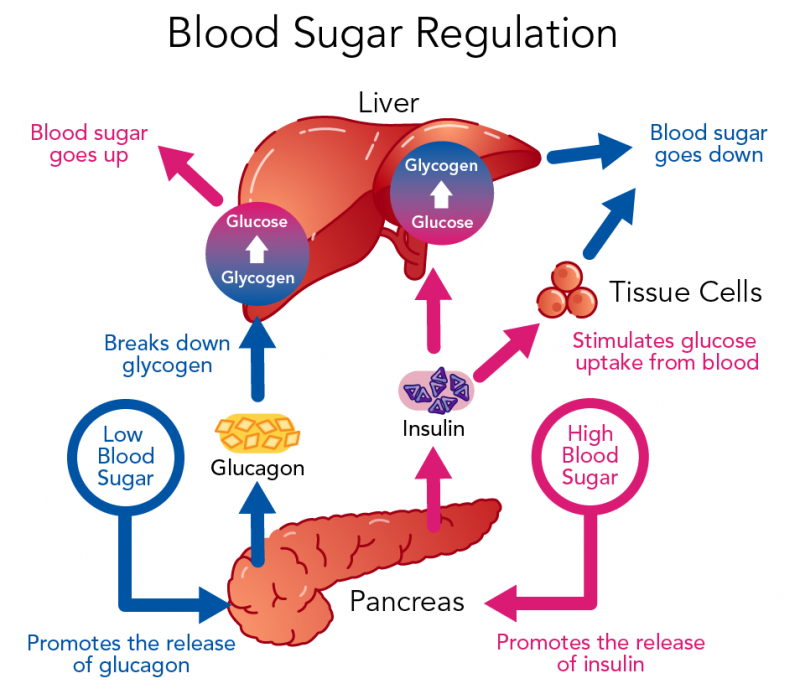Introduction to Homeostasis and Regulation
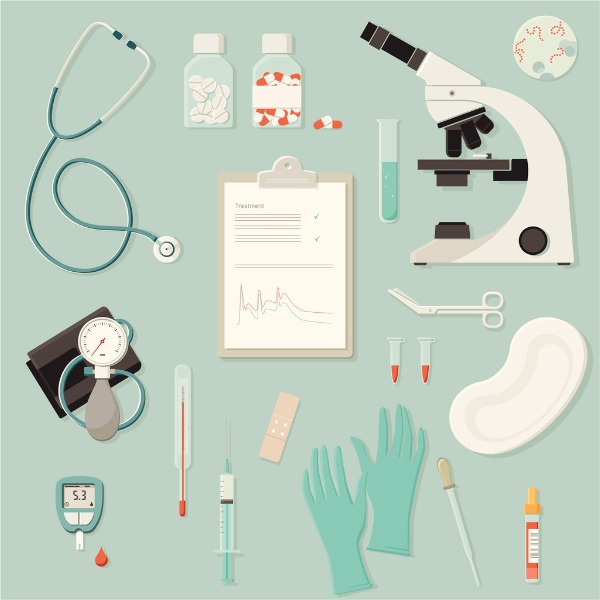
Medical equipment used to check homeostasis (Sabine Bracker, iStockphoto)

Medical equipment used to check homeostasis (Sabine Bracker, iStockphoto)
How does this align with my curriculum?
Learn about homeostasis and how the body regulates temperature, blood pressure, blood pH and blood sugar.
The word homeostasis comes from the Greek words homo, meaning “same” and stasis, meaning “steady”. Your body needs to maintain proper homeostasis. In other words, your body needs to keep some parameters steady in order to function properly.
So what does homeostasis involve? Many things! Your body is a fine-tuned, high-performance machine! In this backgrounder you will learn about some of the important conditions that your body constantly keeps in check.
How Homeostasis Works in Our Bodies
Your brain is the control center for the body. It is constantly checking that all systems are working properly. This is done by communicating with the sensors throughout your body.
For example, temperature sensors in your skin can detect if your body is warmer than normal.The information from these sensors gets passed on to the hypothalamus, which is a section of your brain. The hypothalamus reacts by sending messages back through the nervous system to the organs that need to react. When the temperature is back to normal, the receptors send this new information to the brain. The brain then tells the organs that they can return to normal. This is an example of a negative feedback loop. In this type of regulation, the body reacts to reverse the state it is detecting.
Image - Text Version
On the left is a simple flow chart of a negative feedback loop. At the top is a red diamond shape with the word "stimulus". Below this is an arrow pointing to a green rectangle with the word "variable". Below this is an arrow pointing to a burgundy rectangle with the word "sensor". Below this is an arrow pointing to a purple rectangle with the word "control". Below this is an arrow pointing to a blue rectangle with the word "effector". From the side of the blue rectangle is an arrow that is drawn back to the top stimulus diamond shape.
On the right side is a flow chart of the temperature regulation negative feedback loop. At the top is a red diamond shape with the phrase "Body temperature exceeds 37⁰C". Below this is an arrow to a green rectangle with the words "Body Temperature".Below this is an arrow pointing to a burgundy rectangle with the phrase "Nerve cells in skin and brain". Below this is an arrow pointing to a purple rectangle with the phrase "Temperature regulatory centre in the brain". Below this is an arrow pointing to a blue rectangle with the phrase "Sweat glands throughout the body". From the side of the blue rectangle is an arrow that is drawn back to the top diamond shape.
Many important systems involved in homeostasis involve negative feedback loops. This is because the body wants to maintain balance and will attempt to reverse most changes. Positive feedback loops are much rarer. Giving birth is one example. As the body feels the baby’s head push against it, it reacts by pushing back against the baby's head until birth.
Regulation of Body Temperature
Do you know what the average body temperature in humans is? It is around 37 degrees Celsius. Yours may not be exactly 37 degrees because temperature varies slightly for each person. Average body temperature is the same no matter whether you live in the Arctic or in the tropics. Your body temperature does vary during the day. It is lowest when you sleep, and highest when you exercise.
Did you know?
Scientists have discovered that the average human body temperature is decreasing over time. Men (for whom there was more data) born in the 19th century had body temperatures 0.6°C higher than today.
All of the processes in our bodies have adapted to work best at around 37oC. A higher or lower temperature will affect their efficiency. This is why our bodies have adapted different ways to stabilize our internal temperature. Can you name a few ways your body reacts when it is too cold or too hot?
When It’s Too Hot
When it’s hot outside, you might notice your skin becoming redder. This is because your body’s blood vessels dilate to transfer heat to your skin. This is also why your heart may beat faster. It does so to increase blood flow to the skin to get rid of heat. Your body also reacts to increases in heat by increasing the production of sweat by the sweat glands. Sweat, which is mainly water, allows heat to be transferred into the air through evaporation.
You can try this yourself. Start by blowing on your hand. Then, try doing the same with wet hands. You will feel that the air seems colder when your hands are wet. This system works best when the air is dry. On a humid day your body has more difficulty getting rid of the heat because sweat does not evaporate very well in humid air.
When the body’s temperature stabilizers cannot handle the heat, people can suffer from heat-related illnesses such as heat exhaustion or heat stroke. Heat exhaustion occurs when the body loses too much water and salt from sweat. Symptoms include headache, nausea, muscle cramps, pale and clammy skin, dizziness or fainting, rapid breathing and a rapid but weak heartbeat. If the water lost through sweat is not replaced, it can lead to dehydration. Dehydration is very dangerous because our bodies are made of 60% water. This is why it is very important to always drink lots of water when it is hot!
Image - Text Version
This infographic outlines the symptoms of heat exhaustion and heat stroke. On the left are heat exhaustion symptoms and on the right are heat stroke symptoms. In the centre is a silhouette of a human body shaded magenta with the brain, heat, digestive system and a muscle shaded blue.
On the heat exhaustion side is a line pointing to the brain for the symptom of dizziness and fainting, a line pointing to the throat for the symptom of extreme thirst, a line pointing to the skin for the symptom of excessive sweating, a line pointing to the heart for the symptom of a weak, rapid pulse, a line pointing to the stomach for the symptom of nausea, a line pointing to the skin for the symptom of cold, clammy skin and a line pointing to a muscle in the leg for the symptom of muscle cramps.
On the heat stroke side is a line pointing to the brain for the symptoms of headache and confusion, a line pointing to the body for the symptom of high body temperature, a line pointing to the arm for the symptom of no sweating, a line pointing to the heart for the symptom of a strong, rapid pulse, a line pointing to the stomach for the symptom of nausea, a line pointing to the leg for the symptom of red, hot skin and a line pointing to the body for the symptom of a losss of consciousness.
Hyperthermia, also known as heat stroke, is what happens when the body reaches a temperature over 40 °C. Symptoms include headache, red hot skin, dizziness, confusion, nausea, a rapid strong pulse and a partial or complete loss of consciousness. Heat stroke is extremely dangerous, and can even be fatal. If you see someone with these symptoms, you should call 911.
When It’s Too Cold
When it is too cold, a few things can happen. Blood vessels constrict to prevent heat from escaping through the skin. Muscles may contract to generate heat. This is known as shivering. Goosebumps are a mechanism we have inherited from our ape ancestors. Now they're pretty useless. When we were hairy animals, goosebumps raised the hair to increase the amount of insulating air trapped in our fur. Nowadays, we trap air in the insulating clothing we wear.
Image - Text Version
Shown is a cartoon image of a multicultural group of four people standing in a line wearing colourful winter coats, scarves, hats, gloves and mittens. Wiggly lines are shown around each person to indicate shivering.
Did you know?
When you get red cheeks on a very cold winter day, it’s because small blood vessels in your skin have burst. But it’s nothing to worry about. Your body can heal quickly!
When the body reaches a temperature of 35 °C, it usually goes into a state of hypothermia. When this happens, shivering becomes uncontrollable, skin becomes paler and cold, and it becomes harder to focus and even talk. If exposed to cold for too long, you can get frostbite. This happens when your body attempts to reduce heat loss by reducing blood flow to body parts like fingers, toes, nose and ears. Frostbite can result in the need to amputate the affected body part.
A runny nose is not a direct effect of temperature but it’s related to homeostasis. When the air is cold, its humidity is low. Producing mucus is a way for our bodies to increase the humidity of the air breathed in.
Regulation of Blood-Related Factors
Our blood is essential as it transports nutrients to all of the organs in our bodies. Many systems are involved in keeping its composition and flow as stable as possible. This includes the maintenance of blood pressure, blood pH and the amount of gases and nutrients it carries.
Blood Pressure
You have probably had your blood pressure measured by a doctor. This is the test in which they put a cuff around your arm and pump it up until it squeezes your arm really tight. At the end, the doctor might tell you two numbers, such as 120/80. This is your blood pressure. So why two numbers?
- The first number is your systolic blood pressure. This number indicates how much pressure your blood is exerting against your artery walls when your heart beats.
- The second number is your diastolic blood pressure. This number indicates how much pressure your blood is exerting against your artery walls when your heart is resting between beats.
These two numbers give doctors a good sense of whether your heart is working properly. For adults, blood pressure numbers of less than 120/80 mm Hg are considered within the normal range.
Did you know?
The abbreviation mm Hg means millimeters of mercury. It is a unit of measurement for pressure that is also used in some barometers.
In your body, blood pressure is constantly monitored by two baroreceptors. One is in the aorta. The other is the carotid artery. Applying pressure near your carotid artery can be dangerous because it tells your heart to slow down. This can lead to unconsciousness and a lack of oxygen to the brain, which can be fatal.
Another organ involved in the control of blood pressure are the kidneys. Kidneys control the quantity of water in blood through osmoregulation. They also monitor the concentration of important components in the blood, such as electrolytes. When the concentrations are too high or too low, the kidneys react by decreasing or increasing the amount of water going into the bladder. When you are dehydrated, the body holds onto the water it has to correct for the low volume. This response can cause an increase in blood pressure - which is why it’s good to drink lots of water!
Image - Text version
Photograph of seven multiracial boys in blue sports uniforms drinking bottles of water.
Blood pH Regulation
Our blood needs to have a pH within a very tight range, typically around 7.4. This pH is necessary for body systems to work properly and for the right amount of oxygen to get to tissues in the body. Sometimes, blood pH can be too low or too high. Acidosis is when blood pH falls below 7.35 and alkalosis is when blood pH goes above 7.45.
The respiratory system and the excretory system mainly control the pH of blood through the use of the bicarbonate buffer system.The bicarbonate system involves chemical reactions between water (H2O), carbon dioxide (CO2), carbonic acid (H2CO3) hydrogen ions (H+) and bicarbonate ions (HCO3-).
Image - Text Version
Shown is a chemical equation. Water (H2O) and carbon dioxide (CO2) react to produce carbonic acid (H2CO3). Carbonic acid (H2CO3) can also break down to form hydrogen ions (H+) and bicarbonate ions (HCO3). Both are reversible reactions
The respiratory system is involved with changes in blood pH based on carbon dioxide (CO2) levels. Carbon dioxide is produced in our lungs as a waste product of breathing. When carbon dioxide reacts with water in our blood, it produces carbonic acid. This acid can make our blood more acidic. If the body cannot get rid of CO2 fast enough, it can lead to respiratory acidosis. This situation can be caused by lung disease, blockages in airways and other diseases that impair breathing. The opposite can also happen. If the body gets rid of CO2 too quickly, respiratory alkalosis can occur. This situation can be caused by hyperventilation (such as during panic attacks), pneumonia, drugs and even exercise.
The excretory system is involved with changes in blood pH based on bicarbonate (HCO3-) levels. Increased levels of carbonic acid or decreased levels of bicarbonate can lead to metabolic acidosis. This situation can be caused by kidney disease and kidney failure, prolonged diarrhea as well as ketoacidosis which can happen to people with diabetes. Decreased levels of carbonic acid and decreased levels of bicarbonate can lead to metabolic alkalosis. This situation can be caused by prolonged vomiting and severe dehydration.
The regulation of blood is an example of a negative feedback loop. When blood pH gets either too high or too low, the body works to bring it back to normal.
Image - Text Version
Shown is a diagram of respiratory regulation of blood pH. Two processes are shown- acidosis and alkalosis. In acidosis, blood pH is too low. In alkalosis, blood pH is too high. In both cases, the brain and arteries sense the change in blood pH. The respiratory center in the brain then compares this change to a normal level and initiates a response. In acidosis, the lungs then increase respiration to raise the pH. In alkalosis, the lungs decrease respiration to decrease the pH.
Blood Sugar Regulation
It may seem strange to think about your blood having sugar in it, but sugar, in the form of glucose, is the molecule that our bodies use as a source of energy. Keeping just the right amount of glucose in the blood is the job of two organs that work closely together. These are the liver and the pancreas. The liver and the pancreas are both glands.
Glands are organs that make substances such as hormones, sweat, saliva and even milk! There are two types of glands. Endocrine glands release hormones directly into the bloodstream. These glands are part of the endocrine system. Exocrine glands release substances such as saliva and digestive juices through an opening, or duct, to a body surface.
Did you know?
The liver is considered the biggest gland of the endocrine system.
In the blood sugar feedback loop, the liver and pancreas act both as sensors and messenger organs. The hormones insulin and glucagon are the messages used to communicate information between both organs. These messages are chemical messages. They travel through the blood to allow communication between different organs and cells. Hormones work in a similar way to the neurotransmitters in the nervous system. They are much slower, though, as blood doesn’t travel as fast as impulses in nerves.
Let’s see how the feedback loops work.
When blood glucose is low
When the pancreas senses that blood glucose is too low, islet cells release glucagon. This hormone communicates to the liver and tells it to convert stored glycogen into glucose. The glucose is released into the bloodstream and the blood sugar levels go up.
When blood glucose is high
If the body does not use up the glucose it gets from food, blood glucose levels in the blood go up. When the pancreas senses that blood is too high, islet cells this time release insulin. The hormone insulin helps the cells absorb glucose. This reduces the amount of glucose in the blood. Insulin also triggers the liver to convert excess glucose into glycogen.
Image - Text Version
Shown is the feedback system between the pancreas, liver and body.
On the right hand side of the illustration is a pink arrow that points from the phrase "high blood sugar" to a drawing of a pancreas. Below the arrow is the phrase "promotes the release of insulin". Another pink arrow points upward from the pancreas to a drawing of insulin molecules which are shaded purple. From there another pink arrow points upwards to the right towards a drawing of a group of cells. Below the cells is the phrase "stimulates glucose uptake from the blood." Another pink arrow points upward from the insulin to the drawing of a liver. Above a pink and blue shaded circle is the word "glucose" with an arrow above it pointing to the word "glycogen". From the drawing of the liver and the drawing of the cells are blue arrows pointing to the phrase "blood sugar goes down".
On the left hand side of the illustration is a blue arrow that points from the phrase "low blood sugar" to the drawing of the pancreas. Below the arrow is the phrase "promotes the release of glucagon". Another blue arrow points upward from the pancreas to a drawing of glucagon molecules which are shaded yellow. From there another blue arrow points upward from the glucagon to the drawing of the liver. Above a pink and blue shaded circle is the word "glycogen" with an arrow above it pointing to the word "glucose". Pointing away from the liver is a pink arrow pointing to the phrase "blood sugar goes up".
Most people don’t need to think about their blood glucose levels. This is not the case for more than 2 million people across Canada living with diabetes. Diabetes is a disease in which the body either can't produce insulin or can't properly use it. People with diabetes need to monitor their blood sugar and most often take medication to regulate it.
The Liver: A Super Regulator
The liver is truly a super organ that accomplishes many different functions. One of the liver’s main roles is to produce bile for digestion. It also gets rid of toxic substances such as alcohol, from your blood. It maintains a balance of essential components in the blood such as sugar and fats, including cholesterol. When the levels of these things are high, the liver sends the excess into storage. When the levels are low, it uses what it has stored to re-establish the right levels.
This introduction to homeostasis and regulation in the human body is really only a small glimpse into the complex systems that maintain your body’s health. Scientists are still working hard to understand the different mechanisms and diseases that affect it.
Learn More
Explore the optimal environmental conditions for human life. How do you think your classroom conditions compare to those on the International Space Station? Free project for grades 6-9 students.
Why do we sweat? (2018)
This video (4:47 min.) by TedEd explains all the science behind sweating.
Homeostasis and Negative/Positive Feedback (2017)
This video (6:24 min.) by Amoeba Sisters explains the positive and negative feedback mechanisms through a few examples in the human body.
What Heat Can Do to Your Body (2020)
This article by WebMD presents all the symptoms that can result from being exposed to high temperatures.
The Role of Hormones in Homeostasis
This page by the Yale National Initiative gives detailed information on the role of hormones and explains what happens when systems don’t work.
Diabetes Canada
The Canadian Diabetes Association has information about diabetes including research and healthcare resources.
References
Lab Tests Online (2018). Acidosis and Alkalosis. Retrieved from https://web.archive.org/web/20210305104046/https://labtestsonline.org/conditions/acidosis-and-alkalosis
Lewis III, J. L. (2021). Overview of Acid-Base Balance. MSD Manual, retrieved from https://www.msdmanuals.com/home/hormonal-and-metabolic-disorders/acid-base-balance/overview-of-acid-base-balance
Lumen Learning (n.d.). Respiration Control. Retrieved from https://courses.lumenlearning.com/boundless-ap/chapter/respiration-control/
